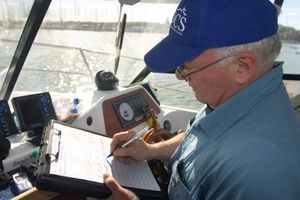Note: This article originally appeared in JetStar, an Australian in-flight magazine. It follows British conventions for spelling and grammar.
At first glance, Port Adelaide doesn’t seem like prime wildlife habitat: the historic buildings and trendy condos lining Fishermen’s Wharf abruptly give way to boats working the Port River and factories crowding its banks. Nature seems to hold little sway here, but take a seat and stay a while. Sooner or later you’ll see the graceful arc of dolphins surfacing for air.
“These are some of the most urbanised dolphins in the world,” said Dr Mike Bossley, an environmental scientist who has studied the Port River pod for decades. “People are surprised they can live here.”
The dolphins, like Port Adelaide itself, have recently made a comeback. Adelaide’s formerly rough-and-tumble port area now boasts a revitalised riverfront, and tourists enjoy dolphin-spotting cruises and the popular “Dolphin Trail.” The new Adelaide Dolphin Sanctuary – the first of its kind in the world – helps protect the river’s most sought-after residents and the United Nations’ declaration of 2007 as the Year of the Dolphin is educating the public about dolphins worldwide.

For much of the past century few – if any – dolphins were seen in the Port River. They figure prominently in Dreamtime stories of the local Kuarna people, but environmental degradation apparently forced them to abandon the area soon after European settlement. Then, in the early 1970s, a large-scale housing project resulted in a constant flow of fresh seawater through the system, and the dolphins have since made a gradual but resounding return.
“On any given day, I’d estimate there are around 20 or 30 dolphins in the area,” Bossley says, adding that the population appears to be stabilizing.
Bossley observes the pod from his research vessel and identifies individual dolphins by distinctive markings on their dorsal fins. A dolphin he calls Captain Hook, for instance, has an unusually long, curved fin. Scarlett has a crescent-shaped scar from a shark attack and Wave has a notch near the tip. These are some of the 30 or so Port River “regulars,” the dolphins Bossley sees week after week, year after year. He has identified about 250 other dolphins who are more casual visitors to the area.

Bossley also observes the dolphins’ behaviour. When they’re traveling, he says, dolphins generally swim together on a steady course and surface simultaneously to breathe. Deep-fishing dolphins often dive for two to three minutes at a time, surface for a quick breath, and then dive again. And when they’re in a playful mood, they like to surf the bow waves of container ships, tugboats, and fishing vessels.
“Dolphins love big boats, absolutely love them,” Bossley says, breaking out in a grin. “They play in the bow wave and it’s just like surfing for them.”

Along with fun and games, dolphins find food and shelter in the Port River area. Thick stands of mangroves provide fish nurseries, so prey is plentiful. Shallow waters in the estuary offer refuge from predatory sharks. The area is also sheltered from wind and large waves, a factor that’s particularly important to mother dolphins and their young.
But living so close to a city of a million people exposes the dolphins to a number of threats. Polluting industries discharge chemicals, heavy metals, and heated water into their home. Boats strike them and fishing line ensnares them. Some dolphins have even been harmed in deliberate attacks.
The Adelaide Dolphin Sanctuary, established in 2005, is an important step toward protecting the local dolphins while considering the needs of industry. The world’s first dolphin sanctuary in an urban environment, it establishes and enforces regulations concerning habitat protection and also funds educational efforts. Two full-time rangers patrol the sanctuary and conduct public awareness campaigns.
Not all the world’s dolphins enjoy such protection, and they need help. Habitat degradation and human-caused death and injury threaten dolphin populations worldwide. In an effort to raise public awareness of their plight, the United Nations, in association with the Whale and Dolphin Conservation Society, declared 2007 the Year of the Dolphin.
Even if you don’t live near the sea, there are lots of ways you can help protect dolphins and their habitat. Urge elected officials to enforce stricter controls on polluting industries, effluent, invasive species, and stormwater. Help keep waterways litter-free and report dolphin harassment to the police. You can even sponsor a dolphin through the Whale and Dolphin Conservation Society, with funds supporting the work of Dr Mike Bossley and other dolphin researchers around the world. Visit www.wdcs.org to learn more.
“We’re enormously fortunate to have dolphins living here,” Bossley says. “People in cities can co-exist with wild creatures, but it takes real commitment. I think Adelaide is beginning to show the world how this can be done.”
Part-time journalist.
Full-time nature nerd.
Do you need to convey complex topics clearly and concisely? I'm an experienced, detail-oriented freelance writer and photographer who's particulary interested in science, nature, and the environment.
Let's talk about how we can work together!